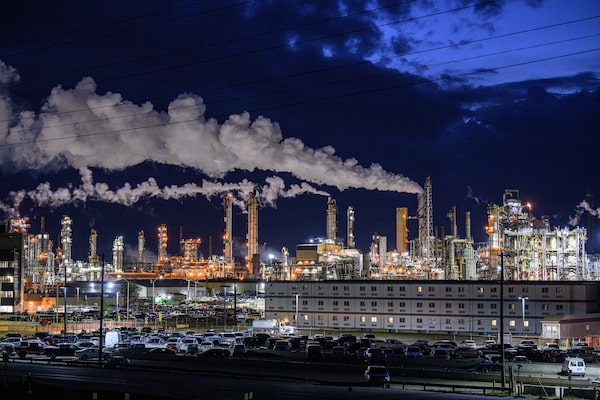
The Syncrude oil sands mining facility near Fort McKay, Alta., on Sept. 7, 2022.ED JONES/Getty Images
It started as a Liberal campaign promise in 2021: to cap – and then rapidly reduce – emissions in the oil business.
The industry has to shoulder a large load as Canada cuts emissions across the economy. The Liberal pledge was easy to advertise, clear and simple, especially viewed against a Conservative climate plan that was (and is) badly lacking.
Turning the promised emissions cap into actual policy has been neither clear nor simple. After two years of work, the final rules are still more than a year away.
Last week, at the United Nations climate meeting in Dubai, the Liberals released the general framework. It fits well with the meeting’s conclusion this week, as countries agreed to transition away from fossil fuels with “accelerating action in this critical decade.”
There are, however, pluses and minuses in the Liberal plan. They set a realistic goal, to cut emissions in oil and gas by at least 20 per cent by 2030. But as the Liberals had signalled, they chose an overly complicated system – one that faces political and legal risks.
The need to push oil companies remains abundantly clear. Their climate ambitions are inadequate. Over the past two decades, Canadian oil output doubled. Emissions per barrel went down but total emissions from the production of fossil fuels climbed about 20 per cent. Across the rest of the economy, they fell more than 10 per cent.
There is some early good news. Oil industry emissions peaked in 2015 and have since fallen about 4 per cent. This is because of federal and provincial rules to reduce potent methane emissions. The success of those regulations shows that emissions can fall if industry is pushed.
The challenge is that oil and gas emissions need to fall by a lot more. This space and others, such as the Clean Prosperity policy group, have argued a more stringent industrial carbon tax on oil and gas was the best strategy. Canada didn’t need yet more bespoke policies. Rules on methane, for example, exist regardless of whether there’s an emissions cap.
The move to deploy cap-and-trade for oil emissions fits the Liberals’ retreat from carbon pricing. In late 2020, they made the carbon tax the central pillar of their climate plans. This fall, under political pressure, they carved out an exception for home heating oil. Now, on a much bigger decision, Ottawa effectively said the carbon tax along with regulations can’t get the job done.
But the draft policy does appear workable. The goals are within reach. The oil sands companies have promised 22 megatonnes of lower emissions by 2030, though they are falling behind schedule because they’ve been too tentative. The Liberal policy forecasts 20 MT from the oil sands.
The Liberals also forecast oil and gas production to rise 10 per cent by 2030 from current record levels, even as emissions are projected to fall. The suggestion that the emissions cap was masquerading as a cap on production has not been borne out. The onus shifts to industry to focus on emissions.
The biggest issues with the Liberal plan are the entwined questions of uncertainty and durability.
Given the legal and political pitfalls on climate policy in recent months, this space has advocated for rules that survive legal battles and changes in government. The Supreme Court validated national carbon pricing and all provinces, Alberta included, accept it on industrial emissions. The emissions cap would probably be ruled onside by the courts as a valid exercise of federal power, based on precedents, but would also grind through a years-long legal slog. Politically, the Conservatives said they’d scrap the plans – and instead talk of technology and “clean” natural gas exports.
This fog of uncertainty leaves Canada in a costly limbo. The Liberals said draft regulations would land in mid-2024, with final rules in 2025 – four years after the idea was proposed. It’s difficult for businesses to make decisions involving many billions of dollars, when proposed rules today could vanish tomorrow. This all follows legal and political upheavals around other climate debates in recent months. It’s turning into a mess, just at the moment Canada should be speeding ahead on big bets for a low-carbon future.
Parcel out blame all the way around. The Liberals should have chosen the simpler, more durable policy. The Conservatives need to get serious on climate. The oil companies must move faster on cutting emissions. With the global promise to accelerate action this decade, Canada has to decide on the rules and get to work.